Comments / Questions (8)
![]() Ingelise Wolter wrote:
Ingelise Wolter wrote:
Den bedste opskrift, nem at gå til. Resultatet en meget velsiddende Balaclava
13.01.2025 - 18:40
![]() Veronique Vigot wrote:
Veronique Vigot wrote:
Bonjour quand vous indiquez diminuer tous les 3 tours comment procéder svp est ce premier rang une diminution 2 rang pas de diminution et 3éme rang une diminution? merci
02.01.2025 - 13:54DROPS Design answered:
Bonjour Mme Vigot, pour diminuer tous les 3 tours, tricotez ainsi: *1 tour de diminutions, 2 tours sans diminuer*, répétez de *à* le nombre de fois indiqué pour la taille. Bon tricot!
02.01.2025 - 16:27
![]() Stine wrote:
Stine wrote:
Garnet der bliver vist på denne model, er det noget der kradser i ansigtet når man får huen på?
15.11.2024 - 14:05DROPS Design answered:
Hej Stine, Hverken DROPS Karisma eller Brushed Alpaca Silk kradser! Men med sagt så har vi også DROPS Merino Extra Fine som er endnu blødere og kan bruges i stedet for Karisma :)
19.11.2024 - 11:19
![]() Geneva wrote:
Geneva wrote:
How do you knit "one ridge over the 4 stitches? "
27.01.2024 - 20:16DROPS Design answered:
Dear Geneva, 1 ridge = work 2 rows in garter stitch (as indicated in the EXPLANATIONS FOR THE PATTERN), which are 2 knit rows. This means that you will knit these 4 stitches in the next 2 rows. Happy knitting!
28.01.2024 - 23:56
![]() Geneva wrote:
Geneva wrote:
How do you knit "one ridge over the 4 stitches? "
27.01.2024 - 20:16DROPS Design answered:
Dear Geneva, 1 ridge = work 2 rows in garter stitch (as indicated in the EXPLANATIONS FOR THE PATTERN), which are 2 knit rows. This means that you will knit these 4 stitches in the next 2 rows. Happy knitting!
28.01.2024 - 23:56
![]() Flaviana wrote:
Flaviana wrote:
If I wanted to use a group D yarn for the size 9-12 years, in this case Drops Melody, how much would I need?
03.11.2021 - 11:58DROPS Design answered:
Dear Flaviana, you will find how to calculate new amount of yarn here - just remember texture will be different when using an alternative. Should you need any assistance, please contact your DROPS store so that they can help you, even per mail or telephone. Happy knitting!
03.11.2021 - 13:24
![]() Flaviana wrote:
Flaviana wrote:
Do I need to use the two strands (1 Karisma and 1 Alpaca) all the way through the hat or just in certain places? For the bigger size, I read that 150g of Karisma are 300m long, but 50g of Alpaca are 167m? Thank you.
03.11.2021 - 11:44DROPS Design answered:
Dear Flaviana, this pattern is worked with 2 yarns held together: 1 strand Karisma + 1 strand Brushed Alpaca Silk (not Alpaca) - Karisma comes in ball 50 g and Brushed Alpaca Silk 25 g/140 m - reason why you require less ball, for ex. in first size you need 2 balls Karisma but just 1 Brushed Alpaca Silk. Happy knitting!
03.11.2021 - 12:22
![]() Karin Wallin wrote:
Karin Wallin wrote:
Hei Kan jeg bruke Drops Air til denne lua? Hilsen Karin
08.10.2021 - 10:14DROPS Design answered:
Hej Karin. Ja du kan byta ut DROPS Brushed Alpaca Silk mot DROPS Air. (Dvs att du stickar den med 1 tråd Karisma och 1 tråd DROPS Air). Se bara till att du får den stickfasthet som uppges på mönstret, och att beräkna riktig garnåtgång. Mvh DROPS Design
08.10.2021 - 11:22
Warm Snuggles Kids#warmsnugglesbalaclava |
|
 |
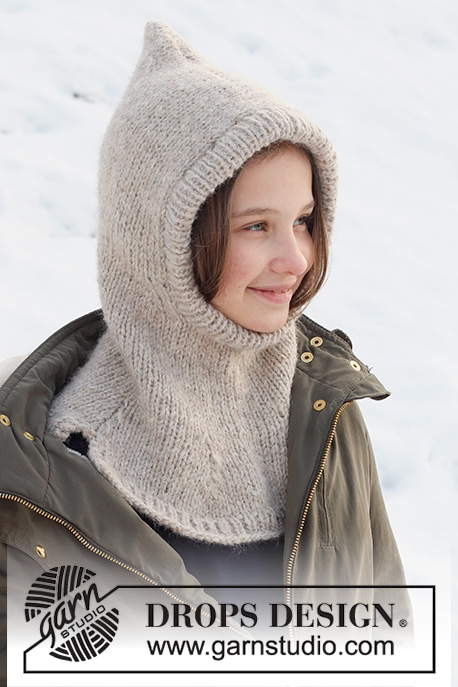 |
Knitted hat / balaclava for children in DROPS Karisma and DROPS Brushed Alpaca Silk. The piece is worked in stocking stitch with ribbed edging. Sizes 12/18 months to 12 years.
DROPS Children 37-27 |
|
|
------------------------------------------------------- EXPLANATIONS FOR THE PATTERN: ------------------------------------------------------- RIDGE/GARTER STITCH (worked back and forth): Knit all rows. 1 ridge in height = Knit 2 rows. DECREASE TIP-1 (evenly spaced): To work out how to decrease evenly, count the total number of stitches on needle (e.g. 51 stitches) minus the edge stitches (e.g. 4 stitches) and divide the remaining stitches by the number of decreases to be made (e.g. 6) = 7.8. In this example decrease by knitting together alternately each 6th and 7th stitch and each 7th and 8th stitch (approx.). DECREASE TIP-2: Decrease as follows before each marker thread: Work until there are 2 stitches left before the marker thread, slip 1 stitch as if to knit, knit 1 and pass the slipped stitch over the knitted stitch (= 1 stitch decreased). Decrease as follows after each marker thread: Knit 2 together (= 1 stitch decreased). DECREASE TIP-3 (each side of face-opening): Decrease inside the outermost 4 stitches on both sides of the face-opening. All decreases are worked from the right side! DECREASE BEFORE THE 4 STITCHES: Work until there are 2 stitches left before the 4 stitches, knit 2 together, work the 4 stitches as before (= 1 stitch decreased). DECREASE AFTER THE 4 STITCHES: Work the first 4 stitches as before, slip 1 stitch as if to knit, knit 1 and pass the slipped stitch over the knitted stitch (= 1 stitch decreased). INCREASE TIP-2 (back): Increase 1 stitch on each side of the marker. All increases are worked from the right side! Work until there are 2 stitches left before the marker, make 1 yarn over, knit 4 (the marker sits between these 4 stitches), make 1 yarn over (= 2 stitches increased). On the next row (wrong side) purl the yarn overs twisted to avoid holes. CASTING-OFF TIP: To avoid the cast-off edge being tight you can cast off with a larger size needle. If the edge is still tight, make 1 yarn over after approx. each 4th stitch at the same time as casting off; the yarn overs are cast off as normal stitches. ------------------------------------------------------- START THE PIECE HERE: ------------------------------------------------------- BALACLAVA – SHORT OVERVIEW OF THE PIECE: The front and back pieces are worked separately, back and forth with circular needle and bottom up until after the split. Then the pieces are joined and continued in the round. Stiches are cast off for the neck and the piece finished back and forth. The hood is sewn together at the top. A ribbed edge is worked around the face-opening to finish. FRONT PIECE: Cast on 51 (55-59-65-69) stitches with circular needle size 5 mm and 1 strand Karisma and 1 strand Brushed Alpaca Silk (= 2 strands). Purl 1 row from the wrong side. Then work the next row as follows from the right side: 2 edge stitches in GARTER STITCH – read description above, * knit 1, purl 1 *, work from *-* until there are 3 stitches left on the row, knit 1 and finish with 2 edge stitches in garter stitch. Work a total of 4 rows of rib. Knit 1 row from the right side where you decrease 6 (7-8-8-9) stitches evenly spaced – read DECREASE TIP-1 = 45 (48-51-57-60) stitches. Change to circular needle size 6 mm and work stocking stitch back and forth with 2 edge stitches in garter stitch on each side until the piece measures 3 (3-4-5-5) cm. REMEMBER THE KNITTING TENSION! Lay the piece to one side and work the back piece. BACK PIECE: Cast on the same number of stitches and work in the same way as the front piece (the front and back pieces are the same). Then join the pieces together for the neck as described below. NECK: Place the front and back pieces on the same circular needle size 6 mm = 90 (96-102-114-120) stitches. Work 2 rounds stocking stitch with 1 ridge over the 4 stitches above the split on each side. Insert 6 markers as follows: Insert 1 marker at the beginning of the round, then the other 5 markers with 15 (16-17-19-20) stitches between each one. Work stocking stitch in the round. AT THE SAME TIME on the first round, decrease 1 stitch on each side of all 6 markers – read DECREASE TIP-2 = 12 stitches decreased. Decrease like this every 3rd round a total of 3 (3-4-4-4) times = 54 (60-54-66-72) stitches. Work 2 rounds without decreasing. On the next round decrease 6 (6-0-6-6) stitches by decreasing 1 stitch after each marker (does not apply to size 3/4 years) = 48 (54-54-60-66) stitches. Continue with stocking stitch until the piece measures 13 (14-16-18-20) cm from the cast-on edge. On the next round cast off stitches for the face-opening as follows: Work 9 (9-9-9-10) stitches in stocking stitch, cast off 6 (10-10-12-14) stitches and work stocking stitch to the end of the round = 42 (44-44-48-52) stitches. Insert 1 marker in the middle of the row (= mid-back). HOOD: Work stocking stitch back and forth with 1 edge stitch in garter stitch on each side towards mid front. AT THE SAME TIME on the next row from the right side decrease on each side of the face-opening and increase mid-back as follows. DECREASE ON EACH SIDE OF THE FACE-OPENING: Read DECREASE TIP-3. Decrease like this every 2nd row (each row from the right side) a total of 3 (3-3-4-5) times on each side. INCREASE MID-BACK: Increase 1 stitch on each side of the marker mid-back – read INCREASE TIP-2. Increase like this every 2nd row (each row from the right side) a total of 4 (4-4-5-5) times. After all the decreases and increases there are 44 (46-46-50-52) stitches on the needle. Continue working until the piece measures 22 (23-24-25-26) cm from the marker mid-back, i.e. from where stitches were cast off mid-front – or continue to desired length (this measurement is the length of the face opening). The piece measures approx. 35 (37-40-43-46) cm from the top down. Cast off with knit from the right side. ASSEMBLY: Sew the top of the hat inside the cast-off edge. EDGE AROUND FACE-OPENING: Start from the right side at the bottom, where stitches were cast off, and knit up 78 (84-90-94-100) stitches around the opening, inside the 1 edge stitch using short circular needle size 4.5 mm and 1 strand Karisma and 1 strand Brushed Alpaca Silk (= 2 strands). The number of stitches should be divisible by 2. Work rib in the round (knit 1, purl 1) for 5 (5-6-6-6) cm. Loosely cast off with knit over knit and purl over purl – read CASTING-OFF TIP. Fold the rib double to the inside and sew down. To avoid the edge being tight and rolling outwards, it is important the seam is elastic. |
|
Have you finished this pattern?Tag your pictures with #dropspattern #warmsnugglesbalaclava or submit them to the #dropsfan gallery. Do you need help with this pattern?You'll find 26 tutorial videos, a Comments/Questions area and more by visiting the pattern on garnstudio.com. © 1982-2025 DROPS Design A/S. We reserve all rights. This document, including all its sub-sections, has copyrights. Read more about what you can do with our patterns at the bottom of each pattern on our site. |
|










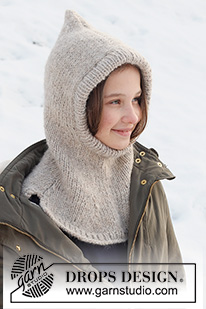
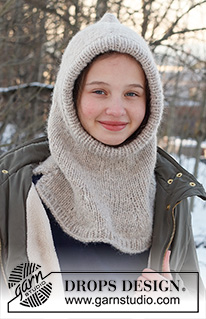
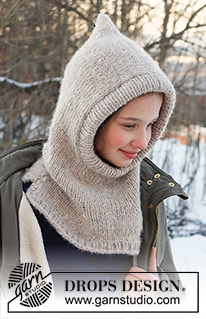










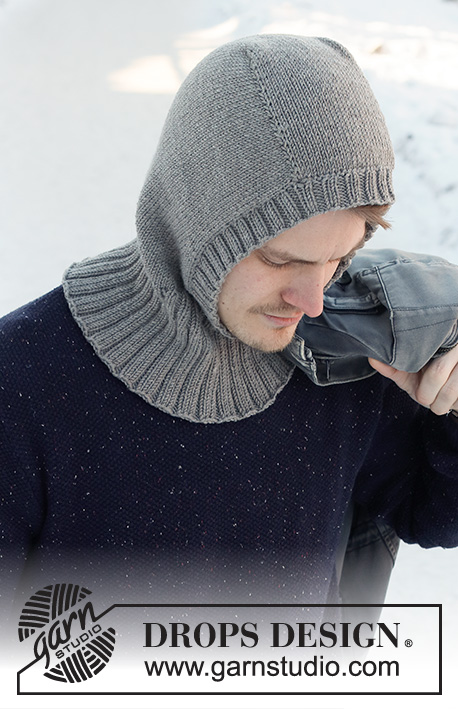

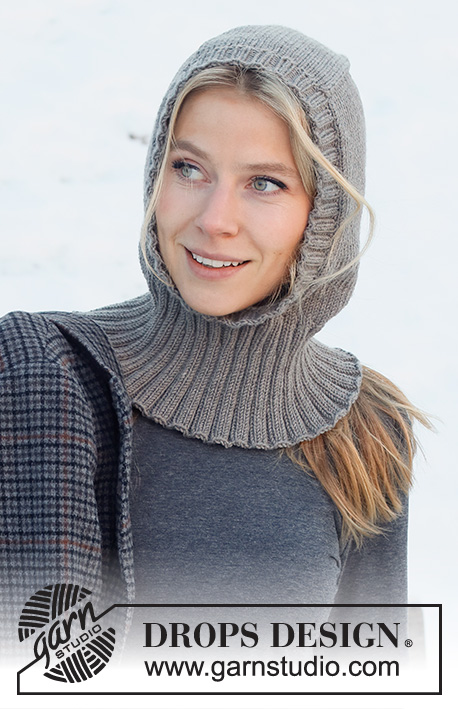
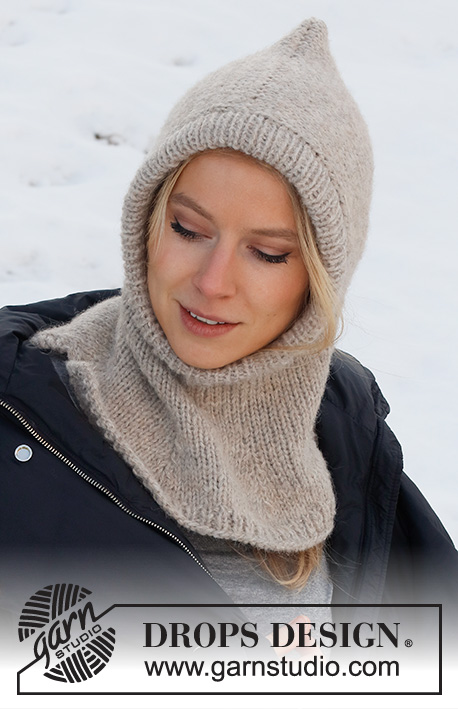












































Post a comment to pattern DROPS Children 37-27
We would love to hear what you have to say about this pattern!
If you want to leave a question, please make sure you select the correct category in the form below, to speed up the answering process. Required fields are marked *.